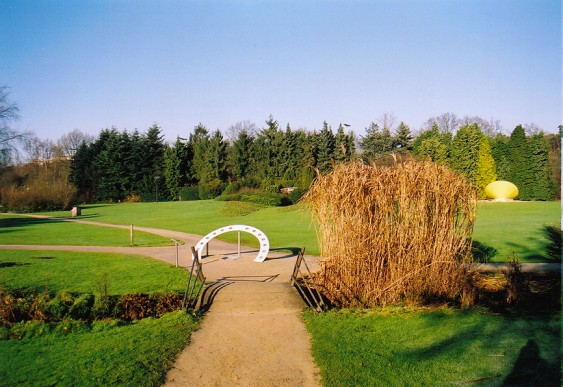
Sundial Park Genk
6. Analemmatic sundial

A park is a natural habitat for an analemmatic sundial. This one got a prominent position, on a crossroads, just beyond a footbridge over the little stream. It fits in there only because of its miniature size: the major axis of the ellipse is only 2 m (6.5 ft). If not, the crossroads might have fit into the dial!
In the background the bifilar dial (nr. 7), the digital dial (nr. 8, barely visible) and the conical dial (nr. 9) can be seen.
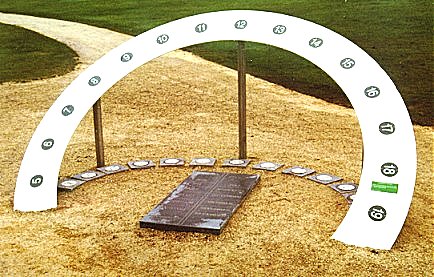
Most analemmatic dials do not or hardly stick out from the grounds, which makes them almost vandal resistant. This one got a strong sculptural presence by means of the inclined circle. Its tilt is 39°, which is the complement of 51°, Genk's latitude. The horizontal ellipse of hour points is therefore the vertical projection of the circle. And, as analemmatic dials use a vertical gnomon, the time can also be read from the hour points on the circle, which lie directly above the corresponding hour points on the ellipse.
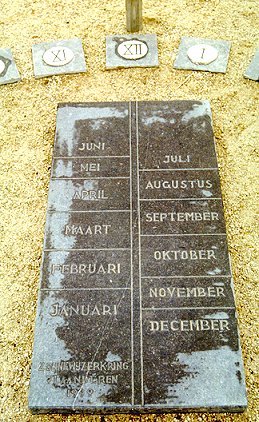 The date line and the month scale have been cut into a slab of granite. The gnomon is placed vertically on the date line at the present date, and its shadow will mark the time on either curve. Local time, in this case.
The date line and the month scale have been cut into a slab of granite. The gnomon is placed vertically on the date line at the present date, and its shadow will mark the time on either curve. Local time, in this case.
René Vinck (Belgium) submitted an interesting design of an analemmtic dial for the Sundial Park project. The object we meet here has only a remote resemblance, as we'll see below.
My comments:
Dial size
Analemmatic dials can be made in any size. For instance, it is fun to make one on a matchbox and use a match as the gnomon (and use the box to store it in). They get really interesting, however, by adding interactivity: let the user him/herself function as the gnomon. By reading the time that way, you may enjoy feeling part of the celestial clockwork for a while...
For use by children, the minimum size would be something like 4 meter (13 ft), and that is about the size of the original design. For adults, 6-7 m would be nice. See my page on the human scale. Was the shrinkage here due to a budgetary problem?
To make a small dial practicable, one could use a vertical rod on a stand. Such a gnomon is present at the analemmatic archetype in Brou (France). And that's not because it is too small for a human gnomon, for its major axis is a full 11.5 m (38 ft)!
Date scale
It looks as if the date scale is way too long: it almost reaches the noon point. A bit illusory, as the actual end points are below the word JUNE and above DECEMBER.
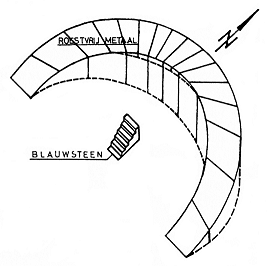 The original design had an inventive date scale, in the form of a staircase. In summer, when one's shadow shrinks, this would extend its range, making it easier to reach the hour ring and read the time. What a beautiful idea! I would have liked to see that realized! Also the inclined circle was planned to look very different.
The original design had an inventive date scale, in the form of a staircase. In summer, when one's shadow shrinks, this would extend its range, making it easier to reach the hour ring and read the time. What a beautiful idea! I would have liked to see that realized! Also the inclined circle was planned to look very different.
The inclined circle
When you understand the principle of the analemmatic dial, it will also be clear how the inclined circle is related. The elliptic hour ring is the projection of an equatorial circle. It is also tilted 39°, but with its northern end down. The circle here is merely the mirror image of such an equatorial circle with respect to the horizontal plane.
A similar inclined circle was used by Gordon Taylor, who designed a precision dial for the Royal Greenwich Observatory, then located in Herstmonceux Castle, at the occasion of its tricentennial in 1975. The gnomon is also vertical, but moves along a diametral rod. The hour scale on the circle is homogeneous, that is, the hour numbers are evenly spaced at 15° intervals. The sundial could show standard time to the minute, as the ring was adjusted regularly so as to include the Equation of Time.
I write 'was', as the RGO was closed in 1998, after it was moved to Cambridge in 1990. The sundial returned to Herstmonceux Castle. No adjustment personnel anymore... (Photo: David Roles, Canada)
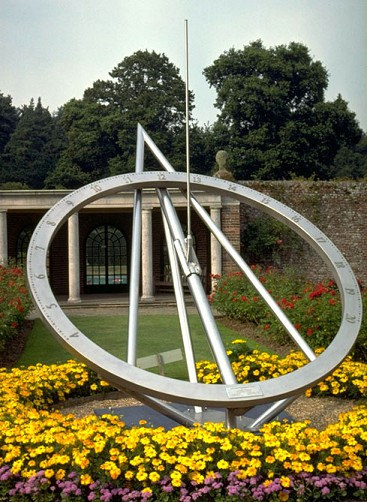
Want more?
More on analemmatic dials (my favorites!) can be found in my analemmatics pages: Introduction and Selected topics.